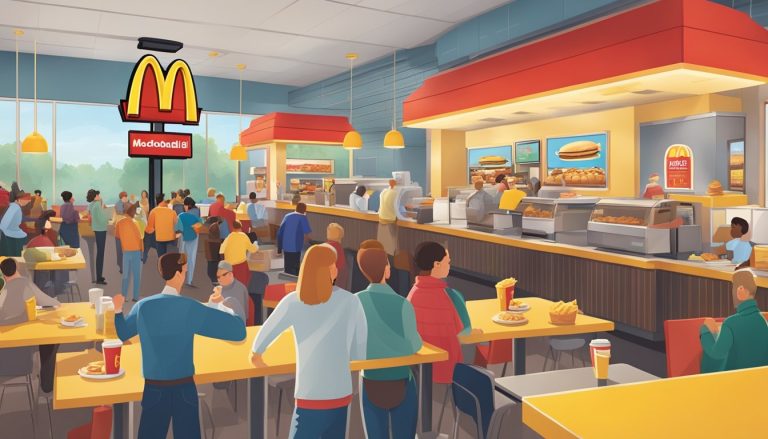McDonald’s breakfast menu has evolved over the years to include diverse options catering to different tastes and preferences. Among these offerings is the breakfast burrito, a Tex-Mex inspired item that combines classic breakfast ingredients with a portable, hand-held format.
McDonald’s Sausage Burrito features scrambled eggs, pork sausage, American cheese, and green chiles wrapped in a soft flour tortilla, all for around $2.69. This affordable option provides a quick and convenient breakfast for those on the go. While not as extensive as some Tex-Mex specialists, McDonald’s take on the breakfast burrito offers a tasty blend of flavors that has become popular with many customers.
The addition of breakfast burritos to McDonald’s menu reflects the growing influence of Tex-Mex cuisine in American fast food. It provides an alternative to traditional breakfast sandwiches and allows the chain to compete with other restaurants offering similar morning options. As part of McDonald’s broader breakfast lineup, the burrito contributes to a menu that ranges from simple items like hash browns to more substantial combo meals.
The Rise of Breakfast Burritos in Fast Food
Breakfast burritos emerged as a popular morning option, transforming fast food menus across the industry. Their convenience and hearty ingredients appealed to on-the-go consumers seeking a filling start to their day.
From Quick Service to Morning Staple
Fast food chains recognized the growing demand for portable breakfast items in the 1980s and 1990s. Breakfast burritos offered a solution, combining eggs, cheese, and meat in an easy-to-eat format.
The Tex-Mex inspired wrap quickly gained traction, appearing on menus nationwide. Its versatility allowed for regional variations and customization to suit different tastes.
By the early 2000s, breakfast burritos had become a standard offering at many quick-service restaurants. Their popularity helped expand morning sales and attracted new customers during traditionally slower hours.
McDonald’s Entry into the Breakfast Burrito Market
McDonald’s added Breakfast Burritos to its national menu in 1991. The item was created by two Houston-area franchise owners, capitalizing on local flavors and preferences.
This addition complemented McDonald’s existing breakfast lineup, which included the Egg McMuffin introduced in 1972. The breakfast burrito provided a different texture and flavor profile compared to sandwich options.
McDonald’s continued to innovate its morning menu, later introducing items like McGriddles in 2003. The company’s breakfast offerings became a significant revenue source, accounting for about 25% of annual sales.
Ingredients and Flavors: A Closer Look
McDonald’s breakfast burritos combine classic ingredients to create a satisfying morning meal. The mix of textures and flavors appeals to those seeking a hearty start to their day.
Eggs: The Foundation of the Breakfast Burrito
Scrambled eggs form the base of McDonald’s breakfast burrito. These eggs are prepared fresh and provide a soft, fluffy texture.
They serve as a neutral canvas, allowing other flavors to shine through. The eggs also contribute essential protein, making the burrito a filling option for busy mornings.
McDonald’s uses whole eggs in their breakfast burritos, ensuring a rich taste and creamy consistency.
Meats and Proteins: Sausage, Chorizo, and Beyond
Sausage is the primary meat in McDonald’s classic breakfast burrito. It adds a savory, slightly spicy element to the mix.
The sausage is typically made from pork and seasoned with herbs and spices. Some locations may offer chorizo as an alternative, bringing a bolder, spicier flavor profile.
For those seeking a meatless option, McDonald’s has experimented with plant-based proteins in select markets.
Cheese and Vegetables: Peppers, Potatoes, and Jalapeños
Cheese plays a crucial role in binding the burrito ingredients together. McDonald’s uses a melty cheese that adds creaminess and depth of flavor.
Green chilies and onions provide a mild kick and fresh crunch. Some variations include diced potatoes for added substance and texture.
For heat-seekers, jalapeños may be available as an add-on at certain locations. These peppers can significantly boost the burrito’s spice level.
Wraps: Tortilla Varieties and Their Impact
The flour tortilla is the vessel that holds all the breakfast burrito ingredients. McDonald’s uses a soft, pliable tortilla that’s easy to fold and eat on-the-go.
While the standard offering is a plain flour tortilla, some markets have tested whole wheat or tomato-basil varieties.
The tortilla’s quality can greatly impact the overall eating experience. A fresh, properly warmed tortilla ensures the burrito stays intact and enhances the flavors within.
Nutritional Values and Health Considerations

McDonald’s Breakfast Burrito offers a mix of protein, carbs, and fats. The nutritional profile impacts dietary choices and health goals.
Caloric Content and Dietary Impact
The McDonald’s Breakfast Burrito contains approximately 300 calories. This represents 15% of a 2000-calorie daily intake. The burrito provides a balanced mix of macronutrients, including protein from eggs and sausage, carbohydrates from the tortilla, and fats from cheese and meat.
Protein content helps with satiety, potentially reducing overall calorie consumption throughout the day. The carbohydrates offer quick energy for morning activities.
Balancing Flavor with Health Benefits
McDonald’s Breakfast Burrito combines taste and nutrition. The egg content provides essential amino acids and vitamins. Cheese adds calcium for bone health. Vegetables in the burrito contribute fiber and micronutrients.
To enhance nutritional value, customers can request extra vegetables. Opting for salsa instead of cheese sauce reduces calorie and fat content while adding flavor.
Special Diet Options at McDonald’s
McDonald’s offers alternatives for health-conscious customers. The Egg White Delight McMuffin provides a lower-calorie option at 250 calories. It uses egg whites and Canadian bacon on a whole grain English muffin.
For those seeking lighter fare, the Fruit & Maple Oatmeal contains 310 calories and offers fiber and vitamins. The Yogurt Parfait, at 150 calories, provides probiotics and calcium.
Customers with dietary restrictions can customize orders. Gluten-sensitive individuals can request items without the bun or tortilla.
Comparison with Other Breakfast Options

McDonald’s breakfast burritos face stiff competition from various morning meal alternatives. These range from traditional sit-down fare to grab-and-go options from rival fast food chains.
Breakfast Sandwiches and Wraps: A Comparative Analysis
McDonald’s breakfast burritos offer a handheld option similar to breakfast sandwiches and wraps. The burrito provides a self-contained meal with eggs, cheese, and meat wrapped in a tortilla. Breakfast sandwiches typically use English muffins, biscuits, or bagels as the base.
Wraps are more similar to burritos but often use different fillings and bread types. Burritos tend to have more ingredients and a larger portion size compared to most breakfast sandwiches or wraps.
Nutritionally, burritos can pack more calories and fat due to their size, but they also offer more protein and fiber in many cases.
Traditional Breakfast Items vs. On-the-Go Eats
McDonald’s breakfast burritos cater to the on-the-go crowd, unlike traditional sit-down breakfast items. Classic breakfast plates with eggs, bacon, and pancakes require utensils and a table to eat comfortably.
Burritos eliminate the need for silverware and plates, making them ideal for commuters. They’re easier to eat while walking or driving compared to items like oatmeal or muffins.
Hash browns serve as a popular side dish for both traditional breakfasts and fast food morning meals. McDonald’s offers hash browns separately, allowing customers to pair them with burritos for a more complete breakfast experience.
McDonald’s Among Competitors: Taco Bell and Starbucks Offerings
In the fast food breakfast arena, McDonald’s faces competition from chains like Taco Bell and Starbucks. Taco Bell leans heavily into the Tex-Mex breakfast category with items like breakfast tacos and their own version of breakfast burritos.
Taco Bell’s offerings often include more Mexican-inspired ingredients such as jalapenos or salsa. McDonald’s burritos tend to stick closer to American breakfast staples.
Starbucks focuses more on coffee and pastries but also offers breakfast sandwiches and wraps. Their options typically target a slightly different demographic, emphasizing premium ingredients and coffeehouse atmosphere.
McDonald’s breakfast burritos occupy a middle ground, providing a quick, familiar option with wide appeal. They balance portability with heartiness, giving customers a filling meal to start their day.
Cultural Impact and Regional Variations

McDonald’s breakfast burritos reflect diverse culinary influences and regional preferences across the United States. Their popularity has grown alongside the broader embrace of Tex-Mex flavors in American cuisine.
The Influence of New Mexican Cuisine on McDonald’s
New Mexican cuisine has significantly shaped McDonald’s breakfast burrito offerings. The use of green chile, a staple in New Mexican cooking, adds a distinctive flavor profile.
McDonald’s incorporated this regional ingredient to appeal to local tastes. Green chile provides a mild heat and earthy flavor that complements the eggs and cheese in the burrito.
The chain’s adoption of New Mexican elements demonstrates its strategy of localizing menu items. This approach helps McDonald’s connect with regional food cultures while maintaining its global brand identity.
Tex-Mex and the American Southwest Tradition
Tex-Mex cuisine, born from the blending of Mexican and American flavors, heavily influences McDonald’s breakfast burritos. The use of flour tortillas, a Tex-Mex staple, reflects this culinary heritage.
McDonald’s breakfast burritos typically feature scrambled eggs, cheese, and meat, mirroring traditional Tex-Mex morning fare. This combination appeals to a wide audience familiar with Southwestern flavors.
The popularity of these burritos has helped spread Tex-Mex breakfast traditions beyond the Southwest. It has introduced many Americans to this regional cuisine through a familiar fast-food format.
Adaptations Across Different Markets
McDonald’s adapts its breakfast burrito offerings to suit various regional tastes. In some areas, they include ingredients like potato or jalapeños to align with local preferences.
The chain’s willingness to modify recipes demonstrates its understanding of diverse American palates. This flexibility allows McDonald’s to compete with local food trucks and restaurants that specialize in breakfast burritos.
In markets less familiar with Tex-Mex cuisine, McDonald’s often introduces breakfast burritos as a novel item. This strategy helps expand the chain’s breakfast menu while introducing customers to new flavors.
Consumer Experience and Brand Strategies
McDonald’s breakfast burrito offering combines convenience, flavor, and brand loyalty. The fast food giant employs targeted marketing, customer retention strategies, and menu innovation to maintain its position in the competitive breakfast market.
Marketing the Breakfast Burrito: McDonald’s Approach
McDonald’s utilizes multi-channel marketing to promote its breakfast burrito. TV commercials showcase the burrito’s ingredients and portability. Social media campaigns emphasize the convenience for busy mornings. In-store displays and menu boards highlight the burrito’s value proposition.
The company tailors its messaging to different demographics. Young professionals receive targeted ads emphasizing quick, on-the-go options. Families see promotions for affordable breakfast combos.
McDonald’s also leverages its mobile app for personalized offers and easy ordering. Push notifications remind customers about breakfast hours and special promotions.
Loyalty and Repeat Customers: Taste or Convenience?
McDonald’s breakfast burrito success relies on both taste and convenience factors. The familiar flavors and consistent quality keep customers coming back. The convenience of drive-thru and mobile ordering appeals to time-pressed consumers.
McDonald’s rewards program incentivizes repeat purchases. Customers earn points for every breakfast burrito bought, redeemable for free menu items. This strategy encourages loyalty and increases visit frequency.
The company’s widespread locations ensure easy access for most customers. This ubiquity reinforces the breakfast burrito as a reliable option for morning commuters.
Innovation in Breakfast: Beyond the Burrito
McDonald’s continuously innovates its breakfast menu to stay competitive. The breakfast burrito serves as a platform for new flavor combinations and ingredients. Limited-time offerings, such as a spicy chorizo version, keep the menu fresh and exciting.
The company explores healthier options to appeal to health-conscious consumers. Egg white variations and whole grain tortillas cater to this demographic.
McDonald’s also experiments with regional flavors. In Seattle, for example, they’ve tested a coffee-infused breakfast burrito to appeal to local tastes. This localization strategy helps maintain relevance in diverse markets.




